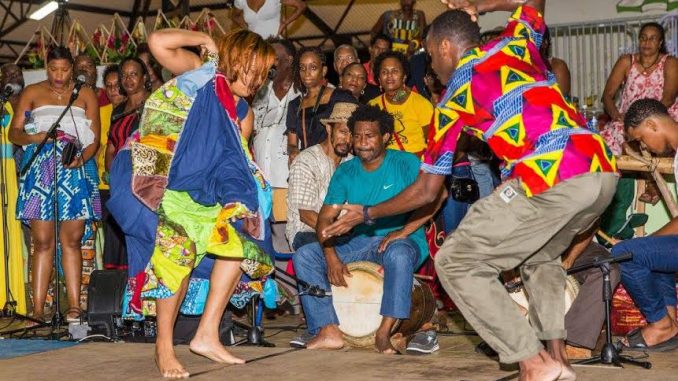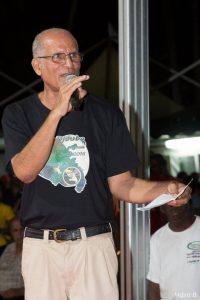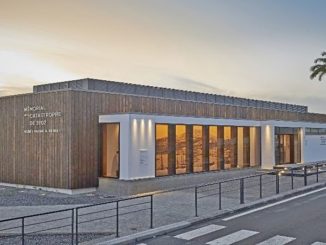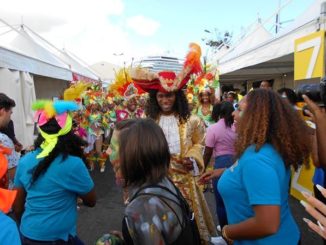
When we talk about Danmyé-Kalennda-Bèlè traditions in Martinique we talk about music, art, dance, war gestures, philosophy, the sacred, the history of this island, passion and enthusiasts. So three volumes were sufficiently dense to discuss these cultural elements so dear to the Island of flowers. It is in any case the formula chosen by the Association Mi Mès Manmay Matinik* (AM4) which celebrates this year its 30th anniversary, to present its research and to place a new stone in the building of the transmission. Started 6 years ago, this large-scale project is the logical continuation of a work initiated in the early 1990s by the realization of 3 brochures that shared the knowledge of the time.

Thus, the volume 1, published in 2012, presents the instruments Ti bwa and Tanbou déjanbé, the volume 2, released in 2013, dissects the dances called Kalennda-Bèlè and the volume 3 which ends the collection in 2016, is dedicated to the Jes Djérié and is accompanied by a DVD that illustrates the 3 opus.
Practical guides rather than novels, these books should preferably be used in interaction with the living culture, if we really wants to feel the soul of this art and to see in motion some very specific gestures that it takes, apparently, years to acquire.
We met with one of the project coordinators, Georges Dru, a founder member of AM4, a former member of AJEM and also Geography-History teacher. He told us more about this wonderful initiative.
 KARICULTURE.NET: These three volumes are quite big, are the traditions Danmyé-Kalennda-Bèlè difficult to learn, to understand ?
KARICULTURE.NET: These three volumes are quite big, are the traditions Danmyé-Kalennda-Bèlè difficult to learn, to understand ?
Georges Dru : Tout bagay compliké é ayen pa kompliké, dépi ou ka mété kow o travay / Everything is complicated and nothing is complicated as soon as you get to work. Bèlè is a way that helps us to estalish relations with us, with the other people, with the cosmos and with the universe. No one I know left the bèlè disillusioned or disappointed, it must bring something.
What we set up in the tradition, it was a training based on the initiatory method and observation. There were the “dèyè won”, while those who knew were working, the others were trying on the sides. We start again largely that and other learning experiences have been added to put in place a structure called “schools”. I prefer the word “schools” because they are not as the French school of the National Education. These are associative schools, cultural schools, like samba schools, capoeira schools or Cuban music schools. These schools allow a greater number of people to have access to this culture, to study it, because it is not only a culture of variety but something which has a level of elaboration that requires sustained learning. Of course, all the Martinicans cannot practice everything in Martinique but they can all protect our culture, respect it.

KARICULTURE.NET : Why and how these books?
G. D. : From the moment when we decided to work, by love, by analysis, on the danmyé-kalennda-bèlè, sa nou di sé : « man pa anvi fè bagay djendjen , fodra nou respekté sa ki ta nou / we said : we do not want to do useless things, we have to respect what belongs to us. There were many prejudices about who we are caused by the racist ideology that accompanied slavery and persisted even after the abolition. It was based on three tripods : “zòt pa bél, zòt pa bon, zòt pa kapab / you are not beautiful, you are not good, you are not able”.
One of the elements of this ideology is “bagay viyé nèg / things for bad negroes”, that means people without culture and “bagay djendjen / useless things”, which are not serious, which are made to amuse. So, we wanted to do the exact opposite of that, to do a serious job, to investigate, because all the peoples, since ancient times, organize a system for transmission of who they are, what they created, their world view, their relationship with the others. In some regions, that became, for example, schools but even when we call that “school”, peoples have initiatory systems, transmission system. Here, sometimes they put into people’s head : “As you were born in there, you do not need to learn”. French is born in France, in the French language, is it not necessary to learn,to read and to write French? We need to study our culture, that was the major axis.

KARICULTURE.NET : What was your working methodology?
G. D. : We have three sources : the community of elders, it is the great book, the great university. Then the testimonies, the traces left by the chroniclers, the witnesses of the time and finally, the meetings with other peoples of the Diaspora and the African continent. As “nou sòti adan menm kannari a / we came out the same stewpot”, there are elements that intersect each other, elements that complement each other, things that they find in us and that we find in them.
From that moment, this information was collected, analyzed, processed, related, checked, compared. For all which is not sure, there are question marks, points of suspension, but they are mentioned anyway.

KARICULTURE.NET : Did you receive any assistance?
G. D. : The first help is ourselves, cé toujou pa la pou koumansé / we must always start there. Nou fè an lo bagay di prop éfò nou, nou apiyé an pil anlè fòs nou / We did a lot of things with our own strenghts, we relied considerably on ourselves, but we also had the support of the former General Council and the former Regional Council, extended by the current CTM (Territorial Authorities of Martinique), the DAC (Department of Cultural Affairs) and some municipalities, especially that of the municipalities where we have workshops.

KARICULTURE.NET : The Guadeloupeans have listed gwoka as UNESCO World Heritage, did you write these books for a similar process?
G. D. : That was not done with a view to being recognized by UNESCO. Our line was always the following : to learn to recognize each other. Often we seek the recognition of the others. For example, some people of the tradition sought and still seek the recognition of the Regional Council, the CTM etc.
That led to the establishment of Coordination Lawonn bèlè : Nou konnèt valè nou, nou konnèt fòs nou, nou ka mété kò nou ansanm, nou ka kréyé an enstitsyon ki ta nou / We know our worth, we know our strength, we come together, we create an institution that belongs to us. It is a coordination which brings together 21 associations and it is a framework that allows us to provide an update, to discuss how the things should be improved, how to maintain them etc. it is our Parliament, it is our institution. On this basis we discuss with the others, the public institutions and the foreign countries. Media are useful too, but if we only work for the media, we will forget the essential, délè ou ka kouri dèyè média pou yo palé di’w, pou fè le ” buzz”, mé travay pwofon an pa ka fèt / sometimes you run after media so that talk about you, for the “buzz” but the in-depth work is not done. Above all, we must work for ourselves, for our community, for our history, as an extension of what the ancestors did and the press, the other external institutions can help us.
Medals symbolize recognition, but if you believe that you are a worthless, even if they give you the medal, you will always chase a rabbit. Now that can help us, it’s an international recognition. If tomorrow this issue arises, well why not, and what we did could be useful. But this is not our priority.

KARICULTURE.NET : Could this recognition be useful for tourism, perhaps?
G. D. : Yes, but we do not work for the tourist but for our community and the tourist takes advantage of it. We are not interested in the tourist who comes for “sea, sex and sun”, the tourist who is interested in our people – and now it is the majority – is interested to see this people in its reality and we see them in the bélè, in the workshops etc.

KARICULTURE.NET : Is there a difference between Guadeloupe and Martinique regarding the transmission of this traditional culture to young people?
G. D. : 70% of people who practice bèlè are young people but the majority of young people do not practice bèlè. Bèlè mobilize people from 4 to 92 years old. I do not know the situation about gwoka.
All the activities of our culture are based on intergenerational relations, as many other peoples, by the way. It is the so-called modern world, organized by capitalism, which tends to separate the generations, but our traditions require that generations are together.
It is true that at a time the bèlè was in danger. Today everyone recognizes that, for 20-30 years, it progressed a lot.
The history of Martinique and that of Guadeloupe are very different. In Guadeloupe, when gwoka recovered its honor, when the identity and nationalist movement progressed, from the years 60-70, Guadeloupe was still a mainly rural society and therefore the arrival of gwoka in the cities, in the towns, is carried out with a strong identity load, with regards to sense, meaning and forms.
In Martinique, where the process began before, when bèlè goes down to the new society, the form of existence it finds, in view of the fact that there was not before all this identity rise, occurs mostly under the form of folklorism, of folk group, which is a structure thought by someone else, to meet someone else’s needs, the development needs of tourism.
I think this is the fundamental explanation, they are two different historic moments. The identity movement developed rapidly at the time when we entered society so that the anchoring process is different.
Having said that, we developed our own forms, Coordination Lawonn Bèlè, bèlè schools etc, the Guadeloupeans developed theirs. Their experience interests us but I believe that our experience also interests them very much.

KARICULTURE.NET : Can we say that these differences are a wealth?
G. D. : I tell you an anecdote : In 1975, we had organized a memorial for Émile Laposte. On this occasion, the Guadeloupean Guy Konkèt met the Martinican Galfétè, a great kalennda player. Impressed by the latter, he told him : “Annou fè an bagay ansanm / Let us do something together”, and Galfétè ka di’y / and Galfétè answered : “fè taw man ka fè ta mwen / Do yours, I do mine”. Konkèt with his gwoka and Galfétè with his kalennda, it gave an unforgettable moment!
You can be useful to others only by being yourself, you can have good relations with the others only by having good relations with yourself and you can love others only if you start loving yourself. Otherwise, you love them badly, you do not know how to love them, you do damage.
Césaire said that the shortest, the most effective, the deepest way to go to universality is the deepening of individuality. Let each of us develop what he is, what he has and share it with the others. As soon as one fades, disappears, does not know who he is, the relationship is not healthy, not balanced, it based on domination, on servility.

KARICULTURE.NET : Is globalization a danger for our traditions ?
G. D. : Globalization is a reality, it is up to us to protect us, to make us stronger. Now there is an asset we do not have : we cannot make laws, we cannot make decisions. We are still subject to a majority of laws that are designed for the French regions. In Cuba, in Japan, Elders are respected, they go to schools. Creole is an official language in New York, this is not the case in France, thus not in Martinique. So, we must fight so that our culture is honored and fully recognized.



